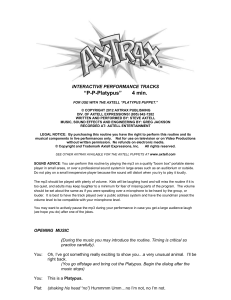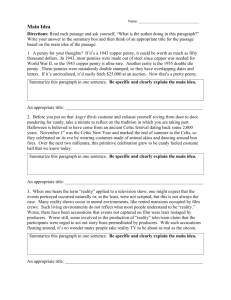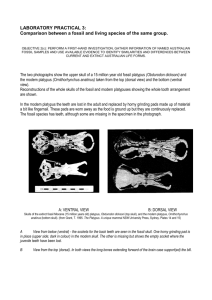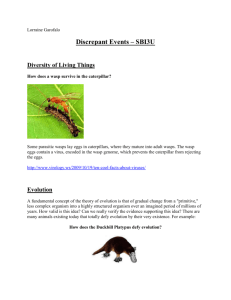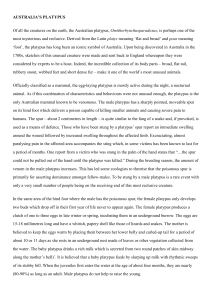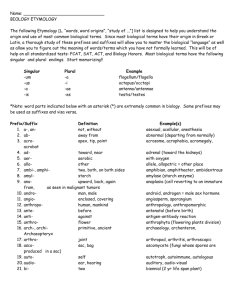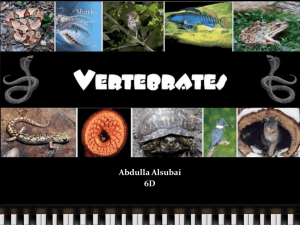Platypus Ornithorhynchus anatinus DESCRIPTION AND CHARACTERISTICS A Mammal? Marsupial?
advertisement
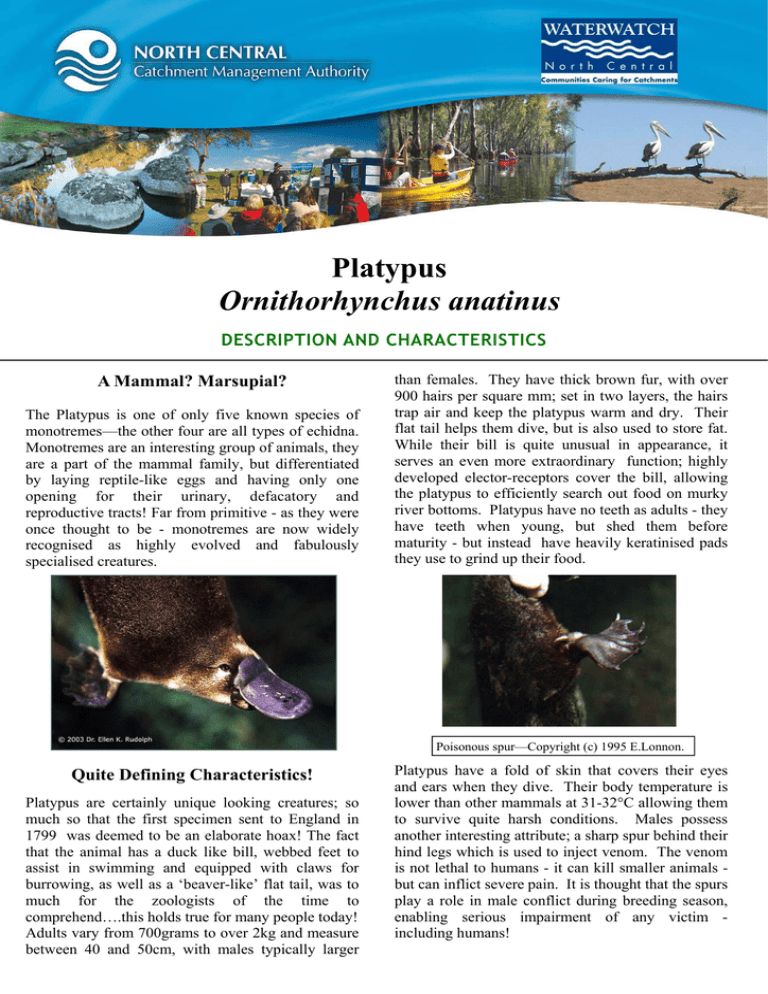
Platypus Ornithorhynchus anatinus DESCRIPTION AND CHARACTERISTICS A Mammal? Marsupial? The Platypus is one of only five known species of monotremes—the other four are all types of echidna. Monotremes are an interesting group of animals, they are a part of the mammal family, but differentiated by laying reptile-like eggs and having only one opening for their urinary, defacatory and reproductive tracts! Far from primitive - as they were once thought to be - monotremes are now widely recognised as highly evolved and fabulously specialised creatures. than females. They have thick brown fur, with over 900 hairs per square mm; set in two layers, the hairs trap air and keep the platypus warm and dry. Their flat tail helps them dive, but is also used to store fat. While their bill is quite unusual in appearance, it serves an even more extraordinary function; highly developed elector-receptors cover the bill, allowing the platypus to efficiently search out food on murky river bottoms. Platypus have no teeth as adults - they have teeth when young, but shed them before maturity - but instead have heavily keratinised pads they use to grind up their food. Poisonous spur—Copyright (c) 1995 E.Lonnon. Quite Defining Characteristics! Platypus are certainly unique looking creatures; so much so that the first specimen sent to England in 1799 was deemed to be an elaborate hoax! The fact that the animal has a duck like bill, webbed feet to assist in swimming and equipped with claws for burrowing, as well as a ‘beaver-like’ flat tail, was to much for the zoologists of the time to comprehend….this holds true for many people today! Adults vary from 700grams to over 2kg and measure between 40 and 50cm, with males typically larger Platypus have a fold of skin that covers their eyes and ears when they dive. Their body temperature is lower than other mammals at 31-32°C allowing them to survive quite harsh conditions. Males possess another interesting attribute; a sharp spur behind their hind legs which is used to inject venom. The venom is not lethal to humans - it can kill smaller animals but can inflict severe pain. It is thought that the spurs play a role in male conflict during breeding season, enabling serious impairment of any victim including humans! HABITAT AND DISTRIBUTION Platypus are semi-aquatic and inhabit small streams and rivers along the Eastern coast of Australia from Tasmania to the base of Cape York. They are found from the cold highlands to tropical forests. They seem to prefer steep-sided well vegetated banks and shallow channels. Platypus construct two types of burrows: nesting burrows and shelter burrows. Shelter burrows are normally rather short and simple, extending up to 2m long with a submerged entrance and no branches. Nesting burrows are longer (5m), with 2 or more entrances up to 80cm above the water line, normally on almost vertical banks. Individuals may utilise up to a dozen burrows and can sometimes be found sharing a burrow, although it is thought that platypus are generally solitary animals. Platypus are most active at night, but feeding may occur during the day and some individuals may be quite active during daylight hours. Platypus are most often seen by humans swimming at the surface with only the muzzle and small part of the head above the surface. Current platypus distribution LIFE CYCLE AND DIET Platypus are seasonal breeders, with ovulation and mating usually occurring during August and September and eggs laid during September or October. Eggs are usually laid into a nest of damp plant matter within the nesting burrow. Females carry nesting material under their tail and will block the entrance to the burrow with twigs and leaves when eggs or young are present. Eggs hatch after about 10 days incubation then young are suckled for about 3-4 months. Females lack defined nipples, with milk released through pores in the skin, pooling in groves on the abdomen for the young to lap up. They feed on a range of invertebrates including: shrimp, mayfly larvae, caddisfly larvae, molluscs and fly larvae. They have a large appetite and can spend up to half of the day trolling for food. Platypus can detect very small movements of their prey using highly sensitive electro-receptors in their bill. IMPORTANCE AND POTENTIAL THREATS The platypus remains relatively common throughout most of its original range apart from the Murray River below Echuca and most of South Australia. Due to difficulties surveying platypus, it is hard to estimate current numbers living in the wild. Although it is thought that platypus are present in a high proportion of river systems across Victoria, NSW and Qld, numbers may be quite low in some, if not many, of the systems. While they are in no immediate threat of extinction, there are still significant threats facing the platypus including: altered river flow regimes and river regulation, declining water quality, loss of bank and riparian vegetation, increased bank erosion, litter (which can cause severe injuries), predation from foxes and cats, as well as other processes that impact on macroinvertebrate communities which make up the majority of the platypus diet. It is very important that platypus populations are conserved due to severe difficulties breeding the species in captivity. Revegetation, bank stabilisation, feral animal control and litter reduction will help ensure that platypus numbers are conserved.


